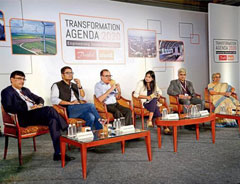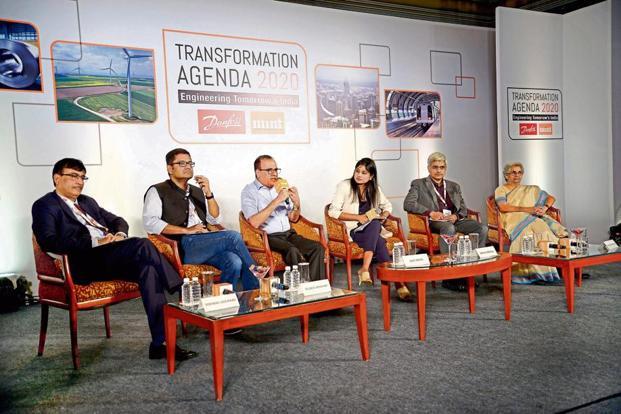
'Smart cities are not only about sensors and gadgets but also mobility, development, jobs'
There is no one-size-fits-all solution to challenges cities face today, said panellists at the 'Danfoss-Mint Transformation Agenda...
infrastructure« Infrastructure section pagePromotional content
There is no one-size-fits-all solution to challenges cities face today, said panellists at the 'Danfoss-Mint Transformation Agenda' on urban infrastructure

(From left) Vishwas Udgirkar, Reuben Abraham, Ajoy Mehta, Shrija Agrawal, Manish Agarwal, and Sulakshana Mahajan at the Danfoss-Mint Transformation Agenda 2020 in Mumbai.
Mumbai: The panel discussion on urban infrastructure challenges, moderated by national deals editor Shrija Agrawal, included Mumbai municipal commissioner Ajoy Mehta; IDFC Institute CEO and senior fellow Reuben Abraham; former urban planner at Mumbai transportation support unit Sulakshana Mahajan; Vishwas Udgirkar, partner and leader, government infrastructure and utilities, Deloitte India; and Manish Agarwal, leader, infrastructure, PwC India. Edited excerpts:
What is the good, the bad and the ugly of urban landscape in India?
Mehta: The key challenge is delivery of services—provide water, take the garbage out. It is good to have conversations on all this. For example, about pollution. We now know that landfills are not an option. We must treat sewage before we dispose it. The second problem is providing infrastructure. We must look beyond roads and bridges when we think of city infrastructure. We should also plan for open spaces, building quality schools and how we can make the city accessible to women and differently-abled people, and how they can participate securely and contribute to the city.
The nature of work by a city’s regulatory bodies has changed. Earlier, receiving licences and permissions used to be a privilege. Now, citizens recognize it as their right. In Mumbai, if you want to set up a shop or establishment, you can get your licence online. It should be transparent and arbitrage-neutral.
Housing in Mumbai is in a crisis situation. We need one million more houses by 2034 and they need to be affordable. We need to focus on the quality of life—how best to make use of the available land, how to use the money. There is no one-size-fits-all solution to this.
Abraham: The primary problem we face in India is the definition of urban. The administrative definition says 26% of India is urban. The census definition says 31%. Between these two official definitions, there are 51 million people. We have onerous definitions for urban in India. At the IDFC Institute, we have measured the population density through geospatial data from the skies, to find out that more than 50% of India’s population lives in urban areas.
So the traditional “rural focus for vote-bank politics” is no longer true. We need to look at cities as economic centres and not as elitist centres. The biggest cities, by gross domestic product (GDP), are bigger than some of the countries. Tokyo’s GDP is bigger than that of Canada, the Netherlands and Spain. Mumbai’s GDP is 60-70% of Maharashtra’s GDP. When you want to create a trillion-dollar economy in Maharashtra, you cannot run away from dealing with Mumbai.
Choices that cities make on leadership and management are extremely vital. If we look at some of the world’s examples here—the UK created an empowered, directly-elected mayor of London who sets policies and executes them through corporatized agencies such as Transport for London. China’s major cities have powerful political appointees as mayors and use focused special purpose vehicles, as in the case of Shanghai’s water supply, to build and run the urban infrastructure. Do you think our cities have to move to a new form of governance structure now?
Mehta: There are issues around each of them. There is no ultimate solution. Some cities have an independent authority. We have a model where there is coordination between different arms of the city government. Every system has its own model. Our cities are not held back, they are moving. Fundamentally, we need to create high-value jobs; housing is a crisis, and we need one million houses by 2024; we must build quality of life infrastructure.
What do you make of the smart cities mission, which is also being seen as the beginning of India’s urban renaissance?
Udgirkar: Today’s need is good governance and infrastructure—we need to bring in internet of things into Indian cities. The best way to that would have been to pick two or three cities and make them smart first. But in India, selecting the first three cities would have taken five years. So we have started out with 100, which is a little ambitious. Out of that 100, maybe three will move faster and they will take the lead. Unless we set ambitious targets, we will not even reach halfway.
Agarwal: India has a three-tier government—the centre, states and cities. The city government rarely has the money it needs. I think any programme should first address that. It is up to each city to make the best use of money. We must empower city managers to have more visibility in their financials and cash flows; they must have some stake in the revenue the city generates. Right now, cities are left to the mercy of the Union and state governments.
If I were trying to attract investors to a city, I would think of where the factories will be located. Are they close to urban amenities? When you do this—provide transport, roads, living spaces—these areas will urbanize instead of becoming just urban sprawls. Smart cities are not necessarily about sensors and gadgets; it should be about mobility, area development and job creation.
Mahajan: The smart city programme, JNNURM—I call these “helicopter schemes”. They just drop money into cities and not apportion for size, demands and needs. A city like Dharamshala has just a ₹6 crore budget, while Mumbai has ₹50,000 crore. Yet everybody gets the same allotment. One thing has to change—cities need to be developed from the bottom up, based on inputs from elected members. It should not be based on what outsiders or consultants say. The smart city vision comes from consultants in the US. Mumbai needs hundreds of transportation planners of its own, urban and public finance planners of its own. If you really want to help, there has to be competition between cities.
Why has affordable housing not taken off at the desired magnitude, despite the government benefits and cheap construction technologies?
Udgirkar: We have to try different models to see what works. We have done work in Bihar and Odisha, where we had bundled residential and commercials complexes. In India, instead of building massive roads and railways, we should look at massive housing construction programmes. This reduces other pressures on cities. It is a reality that people move from villages to cities, but we have to ask whether we are providing comparable living standards. We need to think about better construction technology and must simultaneously ease other pressures on the city. If you look at the National Capital Region, a lot of affordable housing programmes are misused.
Agarwal: I don’t think the government should be in the business of housing, which should be open to competition. It should be in the business of land and permissions, which is a monopoly. Just like we target inflation, in Germany, municipal entities target land prices so that they do not vary significantly. They do this by adding land supply from time to time, and by integrating land use and transport planning. For a builder to be successful, he should compete on cost, time and quality, and not on his ability to get land or permissions.
How would you reimagine an Indian city?
Udgirkar: I’ll pick my city of Gurgaon. It’s a high-income city. The concept of residence being close to work is well-planned. People don’t mind paying for services. But it’s one of the worst cities in India. It’s a concrete jungle and we blame the government, but this city was set up mostly by three private builders. There are no gardens, no cycle tracks; it could have had a good bus transport system. It looks like a fancy city when you fly above it in a plane but the moment you land, there is no civic system, there’s horrible traffic management and no consideration for the environment. But there’s so much we can do to make Gurgaon a smart liveable city.
Abhraham: Mumbai has an astonishing opportunity to reinvent itself with the port land. It has a single owner and it reports to the state government. We can create a special governance zone here and make this into a national financial capital region of India and have a special dispensation around it, like the DIFC in Dubai. This can be the engine for Maharashtra’s growth.
Mahajan: Another opportunity waiting for us to be explored is the upcoming new airport in Navi Mumbai. They have already declared Navi Mumbai Airport Influence Notified Area (Naina) as a third city, but they have messed up the plan. If I was a planner for Naina, I would adopt Cerda’s model for Barcelona, which was created in 1846. It is still working. He considered cities as an always expanding or a shrinking entity, not a limiting one, and you should facilitate it by modular aspects. We need to explore those kinds of models, which are suitable for different cities.New cities like Naina could integrate with villages and not like Navi Mumbai, which has kept aside villages and created two cities within the city. So we have to have integrative, exploratory and innovative models for each city.
Agarwal: I would place my bet on Amravati as a greenfield city. It’s absolutely fantastic planning going on there. It’s never easy to do a greenfield city and as they leverage off Vijaywada and Guntur; there’s a great opportunity to leapfrog ahead and not go through the same path Bangalores and Mumbais have taken, but indeed create something different.
